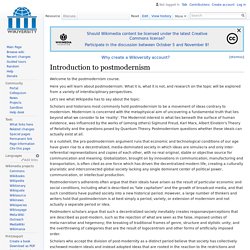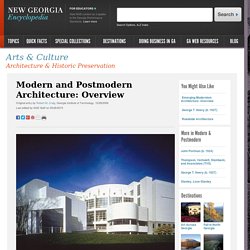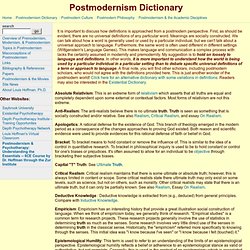

General Introduction to Postmodernism. Introduction to postmodernism. Welcome to the postmodernism course.

Here you will learn about postmodernism. What it is, what it is not, and research on the topic will be explored from a variety of interdisciplinary perspectives. Let's see what Wikipedia has to say about the topic: Scholars and historians most commonly hold postmodernism to be a movement of ideas contrary to modernism.
Modernism is concerned with the metaphysical aim of uncovering a fundamental truth that lies beyond what we consider to be 'reality'. In a nutshell, the pro-postmodernism argument runs that economic and technological conditions of our age have given rise to a decentralized, media-dominated society in which ideas are simulacra and only inter-referential representations and copies of each other, with no real original, stable or objective source for communication and meaning. There are often strong political overtones to this debate, with conservative commentators often being the harshest critics of post-modernism.
Watsuji Tetsurô 1.

Life and Career Watsuji Tetsurō (1889–1960) was one of a small group of philosophers in Japan during the twentieth century who brought Japanese philosophy to the attention of the world. In terms of his influence, exemplary scholarship, and originality he ranks with Nishida Kitarō, Tanabe Hajime, and Nishitani Keiji. The latter three were all members of the so-called ‘Kyoto School,’ and while Watsuji is not usually thought of as being a member of this school, the influence and tone of his work clearly shows him to be a like-minded thinker. The Kyoto School, of which Nishida was the pioneering founder, is so identified because of its common focus; Nishida's important work, East/West comparative philosophy, and an on-going attempt to give expression to Japanese ideas and concepts by means of the clarity afforded by Western philosophical tools and techniques. Watsuji was born in 1889, the second son of a physician, in Himeji City, in Hyogo Prefecture. 2. 3. 4. 5. 6.
Modern and Postmodern Architecture: Overview. Architecture in Georgia during the last four decades of the twentieth century evidenced a continuing interest in traditional forms for much residential architecture, while the state's architects built modern workplaces in the latest contemporary styles.

This interaction between the conservative attitudes expressing lingering Old South values and the progressive viewpoints promoting the latest image of contemporary styling and newly published architectural forms resulted in a split between the "classicists" and "moderns" in Georgia. Moderns versus Classicists and Historic Preservation The battle lines that emerged when modern development accosted traditional neighborhoods and historic districts gave rise to the historic preservation movement. The new architecture, according to the classicists, brought about a numbing of sensibilities with regard to traditional design values and issues of compatibility.
Teach Yourself Postmodernism by Glenn Ward. Postmodernism. 1.

Precursors The philosophical modernism at issue in postmodernism begins with Kant's “Copernican revolution,” that is, his assumption that we cannot know things in themselves and that objects of knowledge must conform to our faculties of representation (Kant 1787). Ideas such as God, freedom, immortality, the world, first beginning, and final end have only a regulative function for knowledge, since they cannot find fulfilling instances among objects of experience. With Hegel, the immediacy of the subject-object relation itself is shown to be illusory. Watsuji Tetsurô. Postmodernism Dictionary. It is important to discuss how definitions is approached from a postmodern perspective.

First, as should be evident, there are no universal definitions of any particular word. Meanings are socially constructed. We can talk about how a word is generally used or used by a particular individual, but we can't talk about a universal approach to language. Furthermore, the same word is often used different in different settings (Wittgenstein's Language Games). This makes language and communication a complex process with lacks the certainly assumed in modernity and premodernity. Absolute Relativism: This is an extreme form of relativism which asserts that all truths are equal and completely dependent upon some external or contextual factors. Anti-Realism: The anti-realists believe there is no ultimate truth. Apologetics: A rational defense for the existence of God. Bracket: To bracket means to hold constant or remove the influence of. Capital "T" Truth: See Ultimate Truth. Does God exist? Postmodernism. Considered a reactionary movement opposed to modernism, which is increasingly thought of as sterile and totalitarian, Postmodernism is an intellectual, cultural movement, whose beginnings are rooted in the latter half of the twentieth century.

"I pursue no intentions, no directions; I have no program, no style and no mission. " (Gerhard Richter, 1993) I. History and definition of the term Postmodernism The terms "Postmodernism" and "postmodern" were in use in the late 19th century and became even more common in the early 20th century, although they did not take on the meaning attached to them today until the 1950s.
II. Lyotard and other theorists describe the intellectual foundations of Modernism as an unshakable belief in constant progress toward an increasingly detailed understanding of he world and a gradual approach to comprehensive knowledge. III.